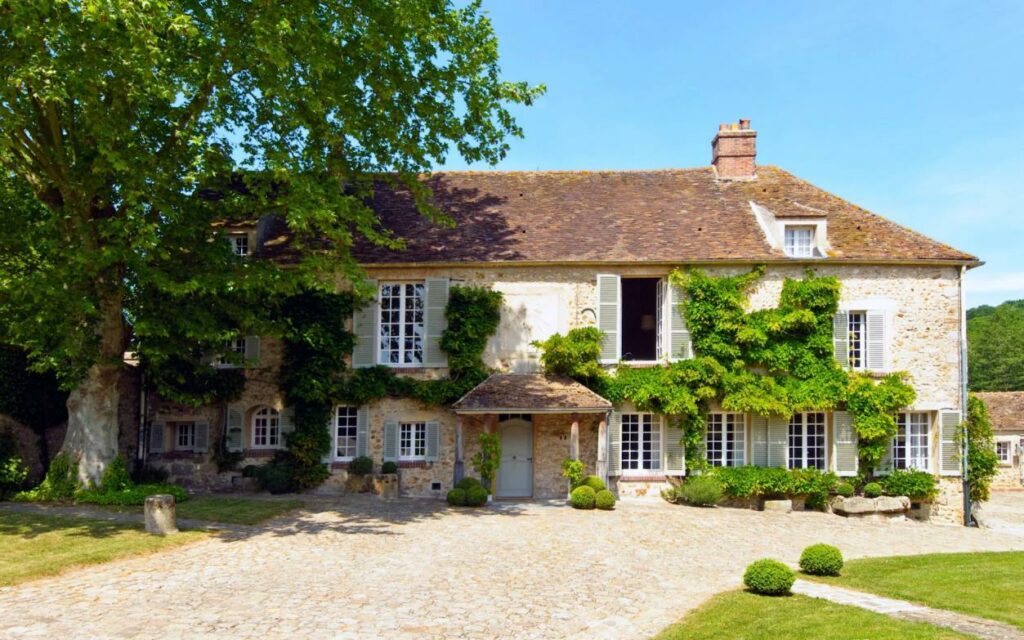
Inside Edward VIII and Wallis Simpson’s French party house – now on sale for £5.6 million
News that the French country house of the Duke and Duchess of Windsor, Le Moulin de la Tuilerie – which Wallis Simpson called “our only real home” – is for sale for £5.6 million, fuels nostalgia.
The Windsors were exiled to France when Edward VIII abdicated, but longed to return to Britain to create their marital home. In contrast, the Duchess of Sussex, our more recent American divorcee turned royal wife, is happily nesting in Frogmore Cottage, near where Wallis lies in the historic royal burial ground, facing the lake.
How Wallis, who was infertile, would have adored to be awaiting the birth of her child – and for Frogmore to echo with the patter of tiny feet. She admitted that her “one continuing regret” was never knowing “the joy of having children of my own.” Instead, it was the Windsors’ succession of pugs, who became the couple’s child substitutes.
Today the pugs’ headstones lie smashed up in the courtyard of The Mill (as it was known). This once glittering party house, where the Windsors played Canasta into the early hours with Maria Callas, Marlene Dietrich, Elizabeth Taylor, Richard Burton and Cecil Beaton, is a haunting reminder of their love and tragic fate. Its latest incarnation as a B&B – it has 26 acres and sleeps 36 guests – is now being sold by The Landmark Trust.
Tellingly, it was a lengthy 16 years after the abdication before the duke finally bought a property in France, in 1952. Although Edward pined to return to his adored home, Fort Beldvere in Windsor Park, Tommy Lascelles, King George VI’s private secretary, said that his presence would be “a constant agony (I use the word advisedly) to the present King, which might have really serious consequences.”
When the duke managed to persuade the Chancellor of the Exchequer, Rab Butler, to release £30,000 from his capital in England, which was blocked by currency control, to purchase an eighteenth century mill outside Paris, it was a grudging acceptance of defeat. England would be his home no more.
After endless lavish French rentals, Wallis craved a house to make her own. A gifted interior designer – to whom presentation was nothing less than a moral issue – she was influenced by two design legends, Syrie Maugham, wife of novelist Somerset Maugham, and her good friend, Elsie de Wolfe. She adopted Elsie’s streamlined aesthetic and her
credo: “what surer guarantee can there be of a person’s character, natural and cultivated, inherent and inherited, than taste?”
The purchase of The Mill gave Wallis a substantial project; a cobbled courtyard, outhouses and large barn were transformed into entertaining areas and guest cottages. One wall of the barn was covered with a map of the duke’s world travels when he was Prince of Wales, while Wallis’s decorator, Stephane Boudin, created her jeu d’esprit in imposing letters on the wall of the sitting room: “I’m not the miller’s daughter, but I have been through the mill.” This frescoed trompe l’oeil depicting a ribbon running through a mill wheel remains today.
The duke made an exact replica of the rock garden at Fort Belvedere, with alpine blooms and water splashing from a small steep hill. I have stood in the rock garden at Fort Belvedere, made from the stone that Edward had hewn and delivered from Yorkshire, staring wistfully at its uncompleted state. He was forced to abandon it when he abdicated.
In France he commissioned designer, Russell Page to recreate a traditional English country garden, with two herbaceous borders filled with flowers he loved – delphiniums, phlox and asters. The head gardener, Edouard Kruch, was Alsatian, to whom the duke spoke in German. (Unlike Wallis, Edward never learned nor spoke French.) Endearingly, though, the child-like duke read comics with Kruch’s sons in the Indian tepee he installed for them in the garden.
“It was the prettiest, most cheerful place imaginable,” remembered frequent guest, Diana Mosely. Fashion editor, Diana Vreeland was intrigued by the duke’s bathroom: he had a special wooden board made to cover the bath, which was piled high with papers. When Vreeland and Wallis collapsed with giggles at this messy male domain, the duke appeared. “May I ask you two ladies to get the hell out! This happens to be my bathroom and that happens to be my table,” he roared in mock indignation.
The biographer, James Pope-Hennessy spent a weekend at The Mill in 1957. “Every conceivable luxury and creature-comfort is bought, called-on, conscripted to produce a perfection of sybaritic living,” he wrote. “The Queen Mother at Clarence House is leading a lodging house existence compared to this.”
A friend, Ruthie Burgess, who went to stay at The Mill last year, found it a poignant experience. While it is “magically redolent still,” there is something broken about it. “A sadness lingers in the air,” she told me. “You have such a sense of a couple who were trying to create a piece of England and a home fit for a monarch in what is fundamentally quite a shabby house.
“Wallis made it delightful and everywhere you see their initials, WE, entwined in the ironwork. You sense their love and the love that went into it and while you know that it was an amazing party house, you can’t help but feel sad about what it was and what it represented.”